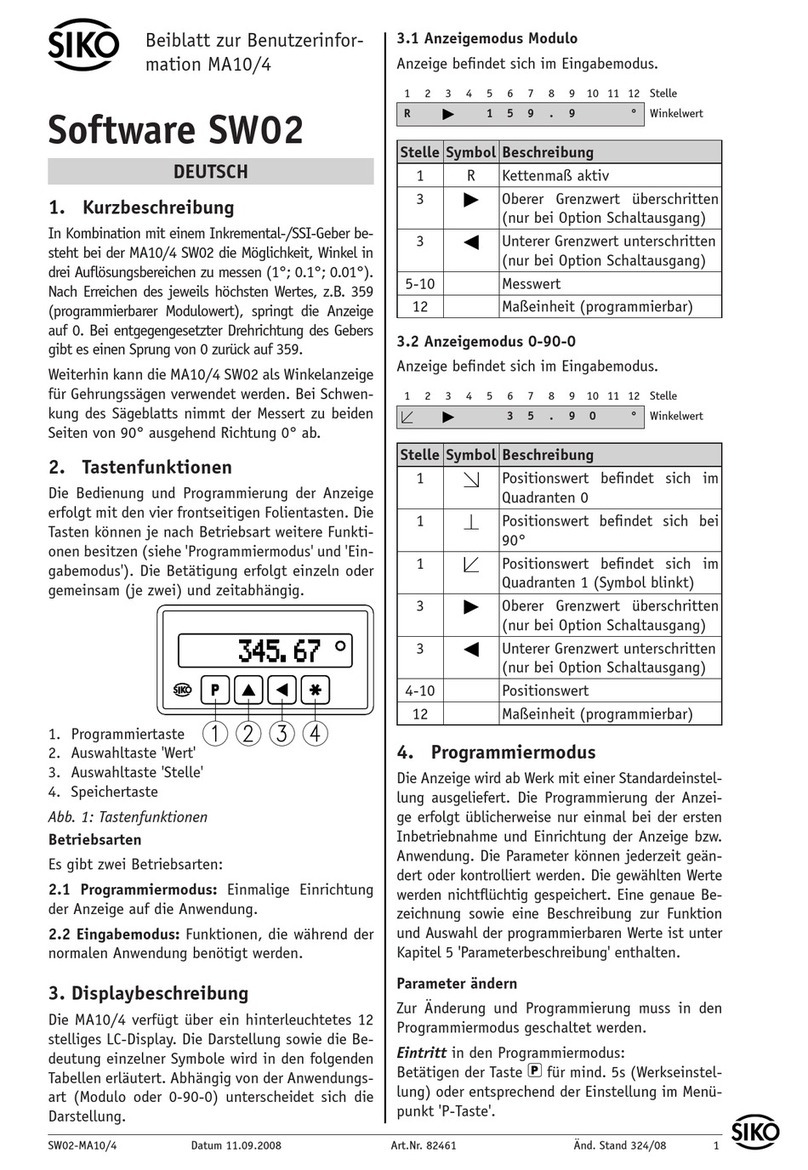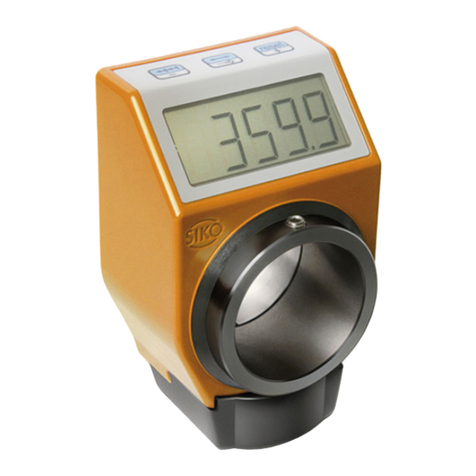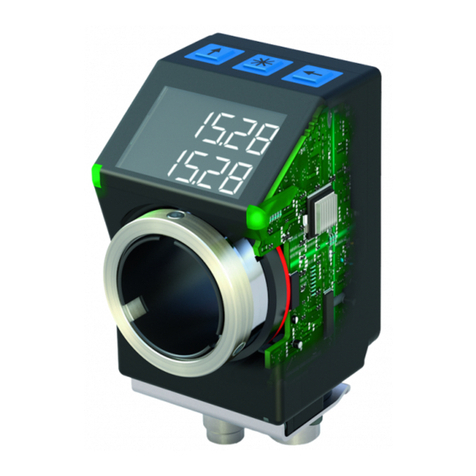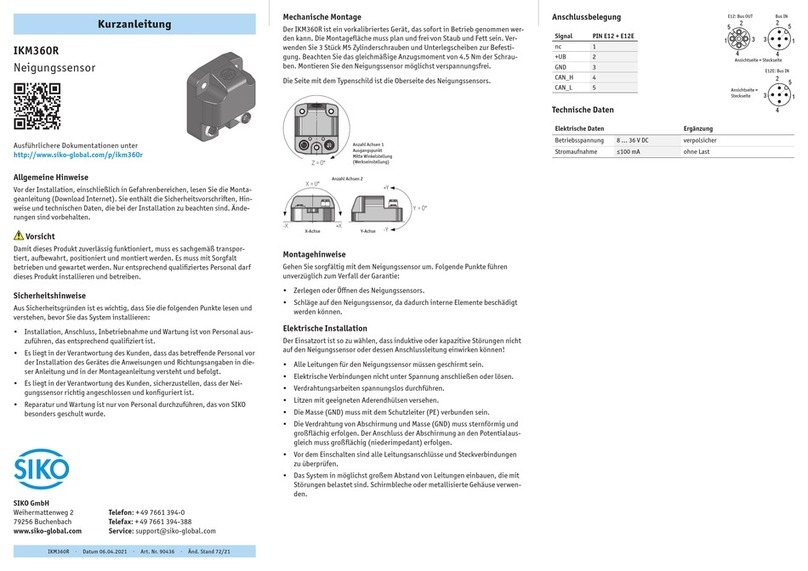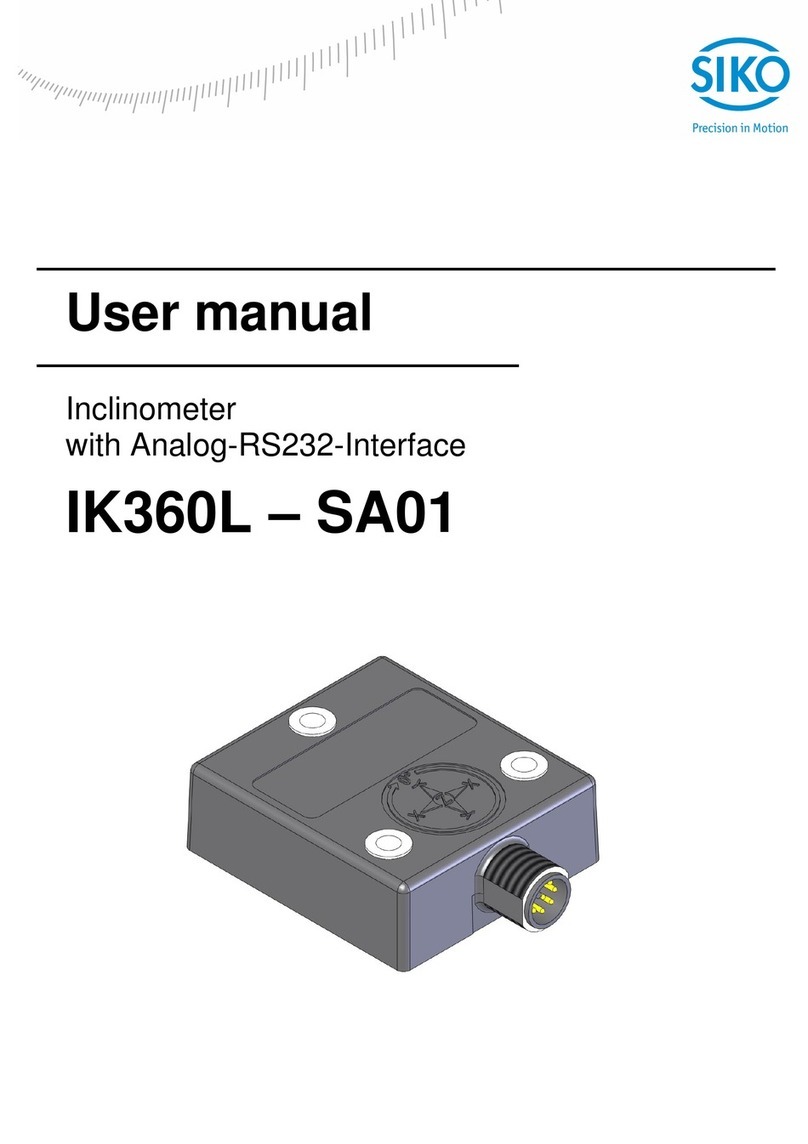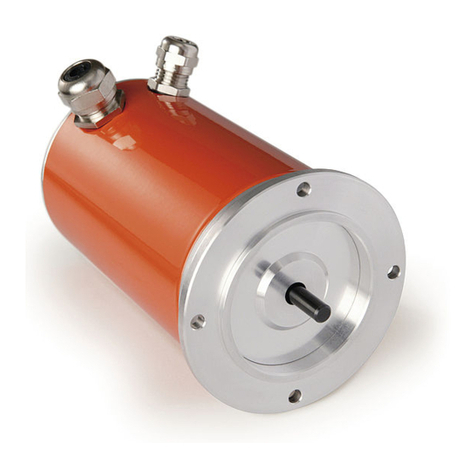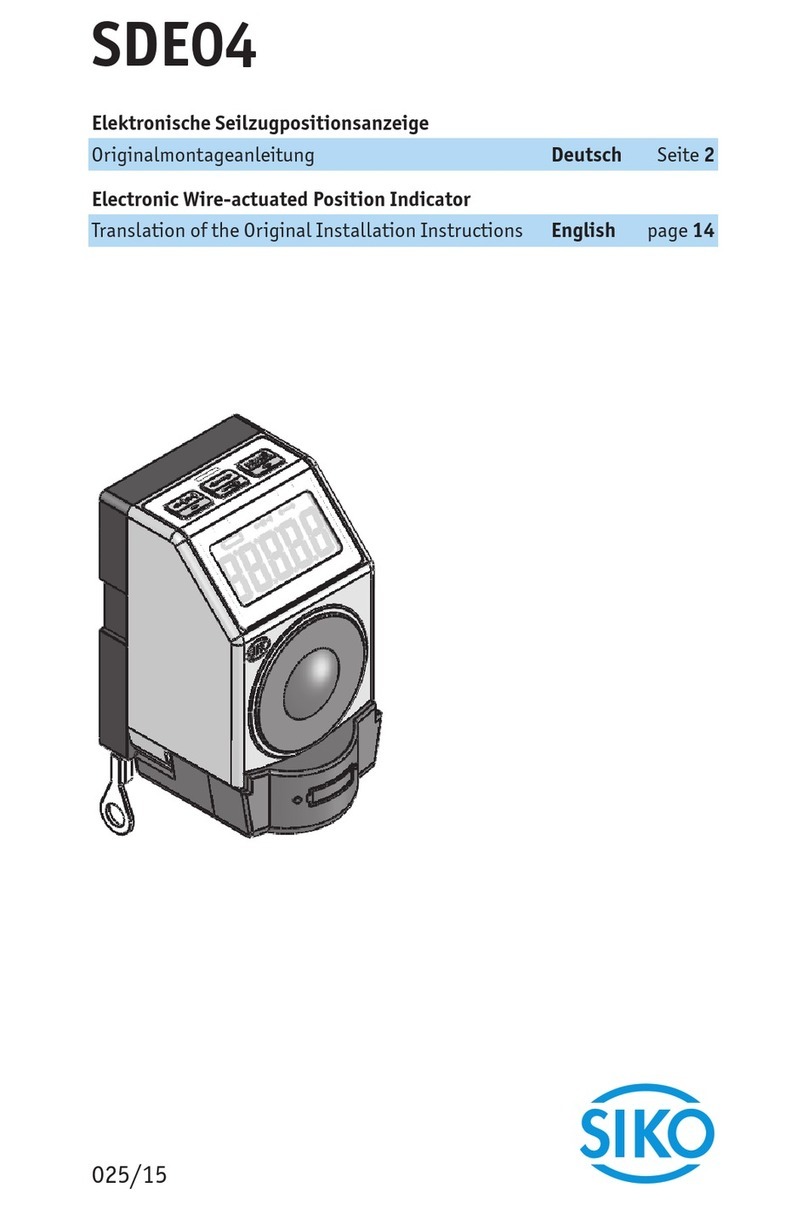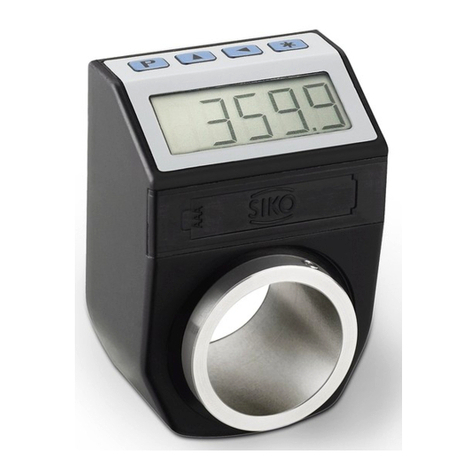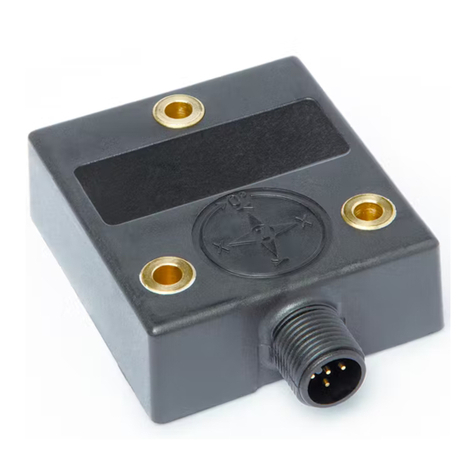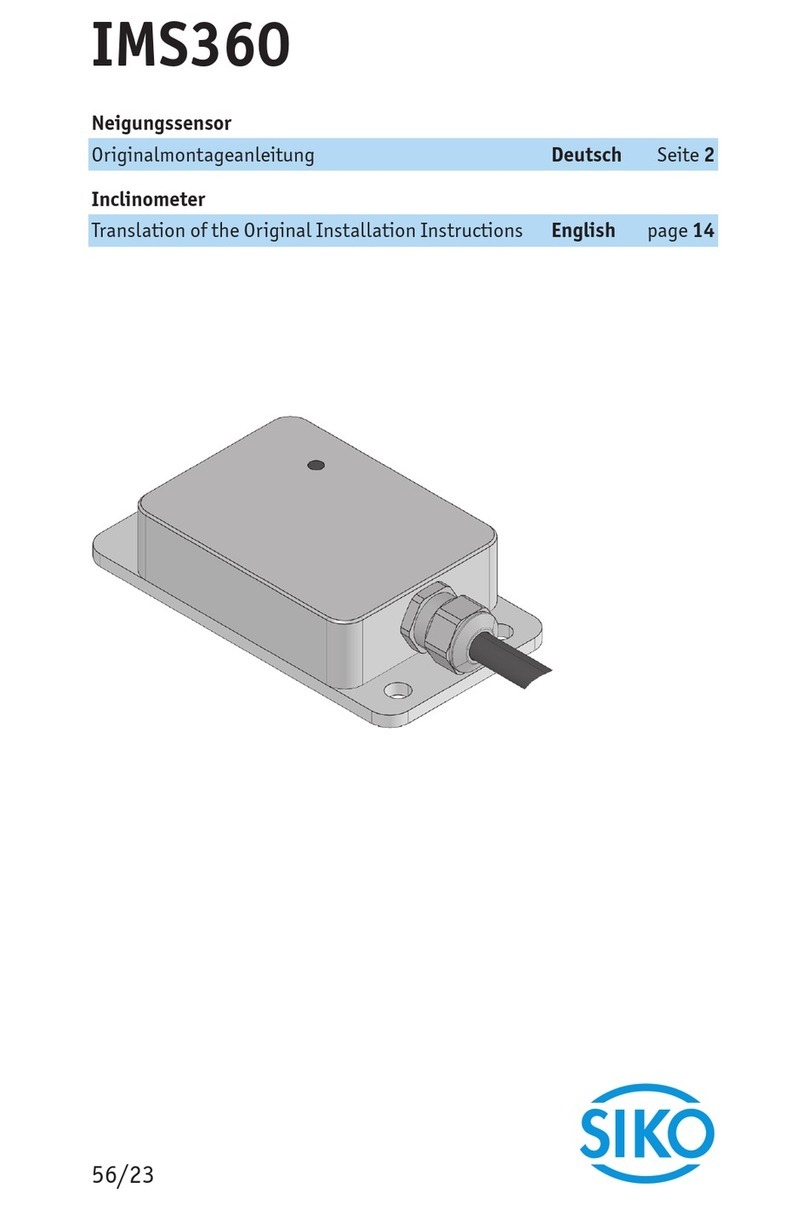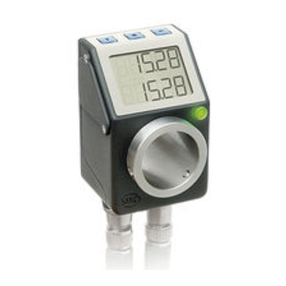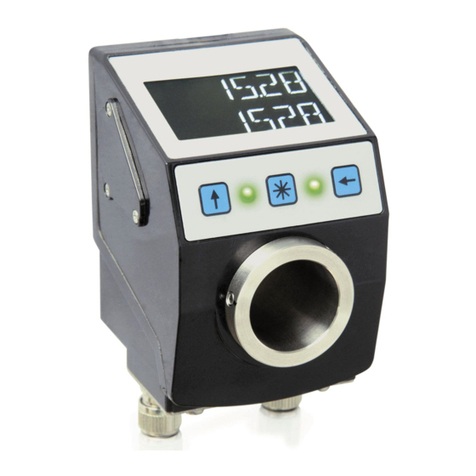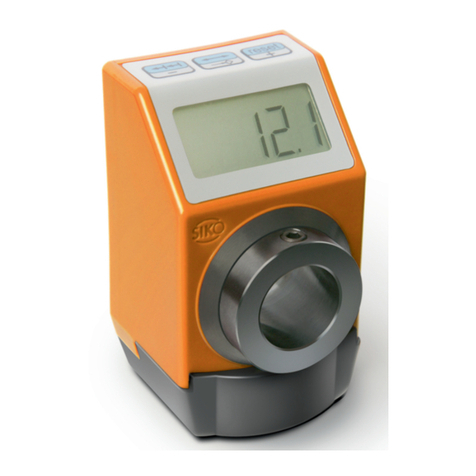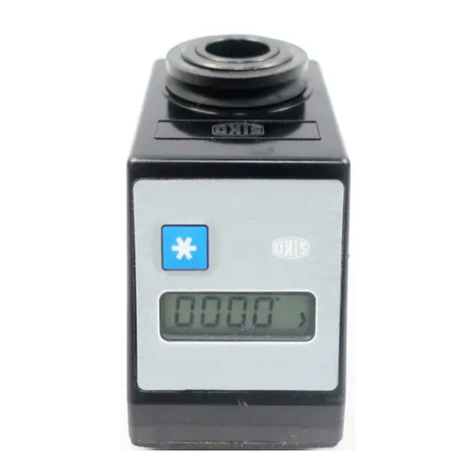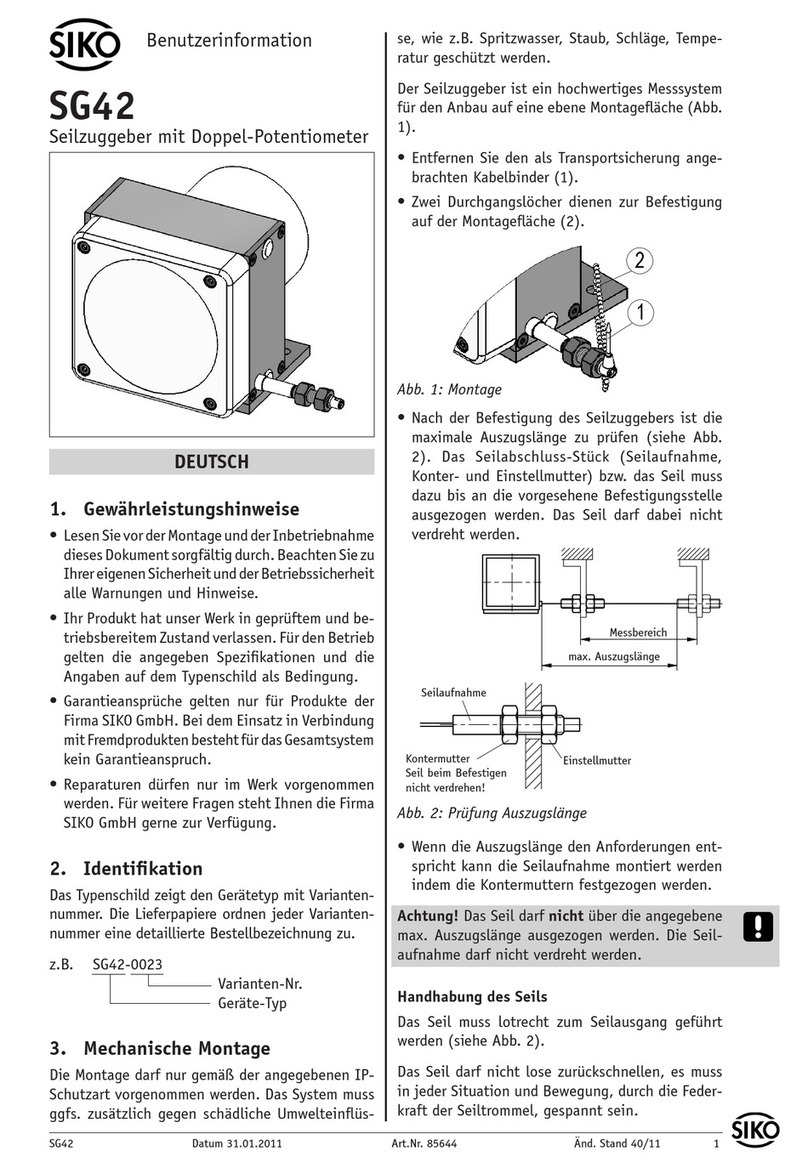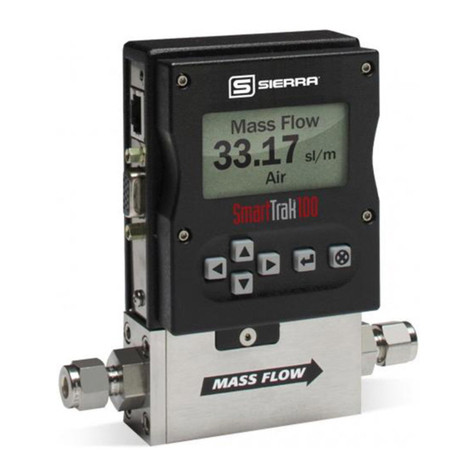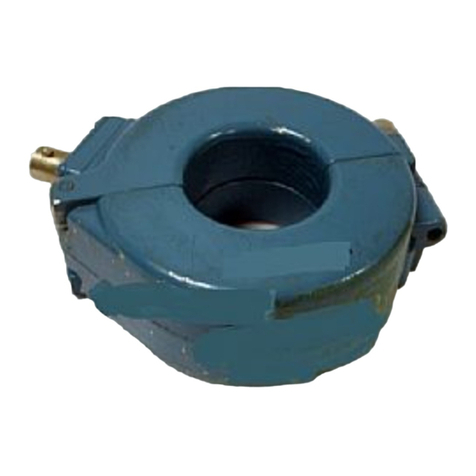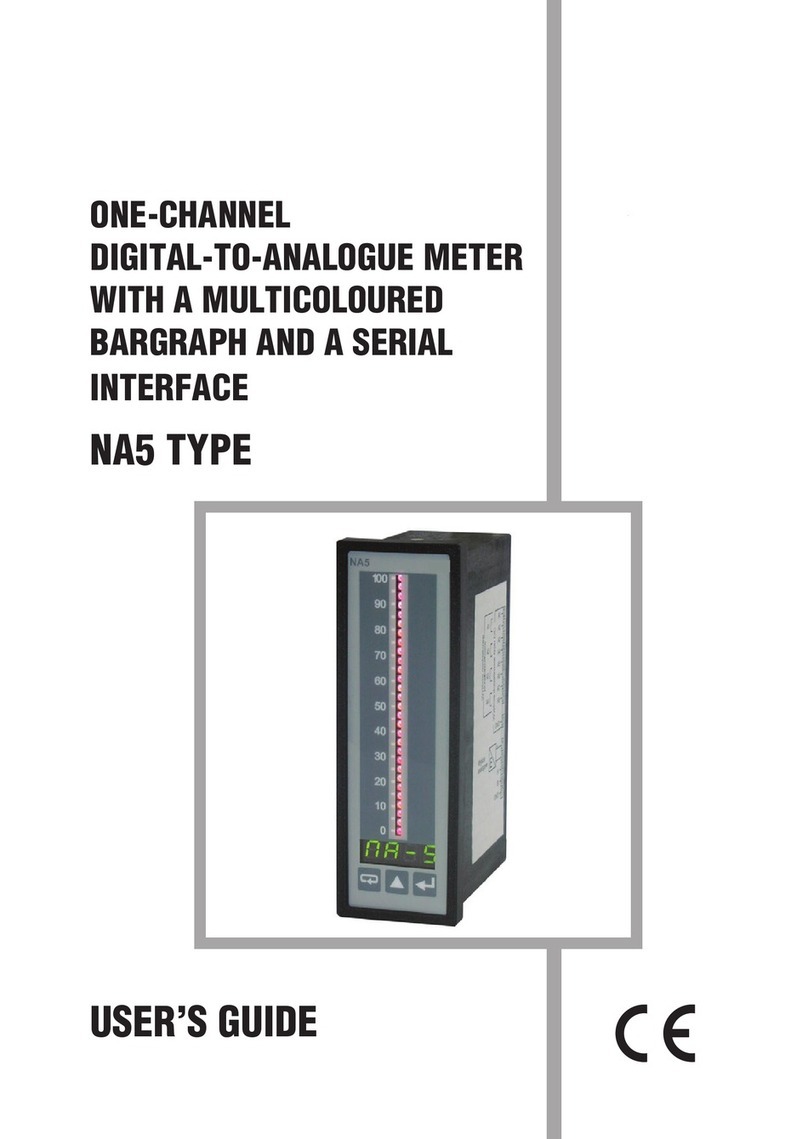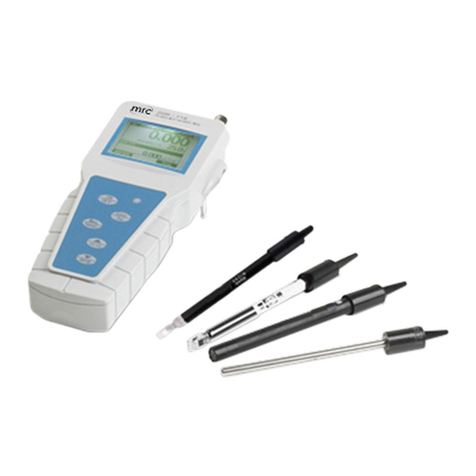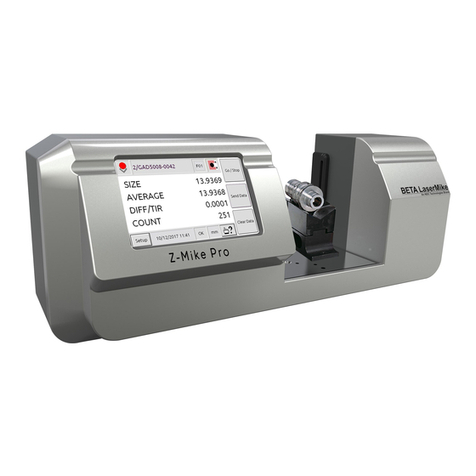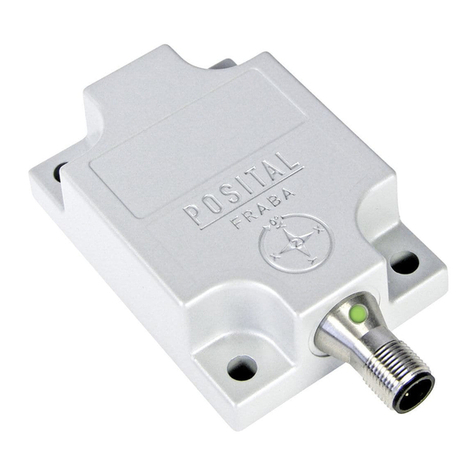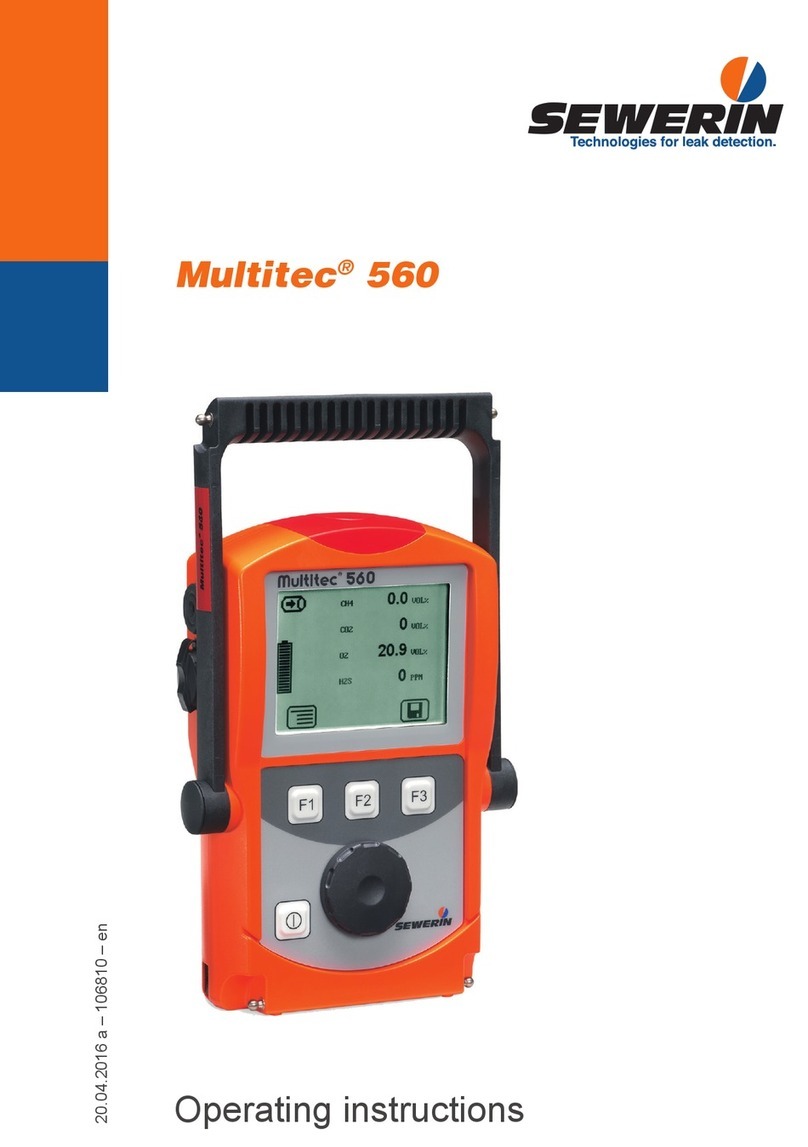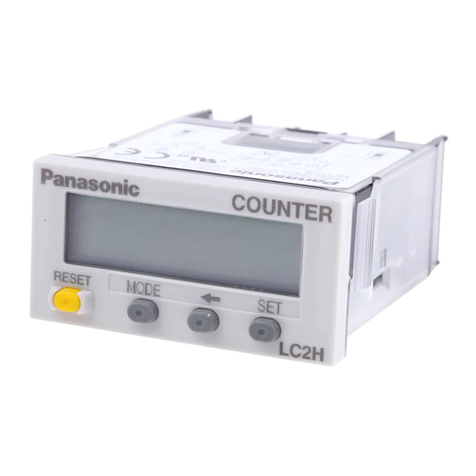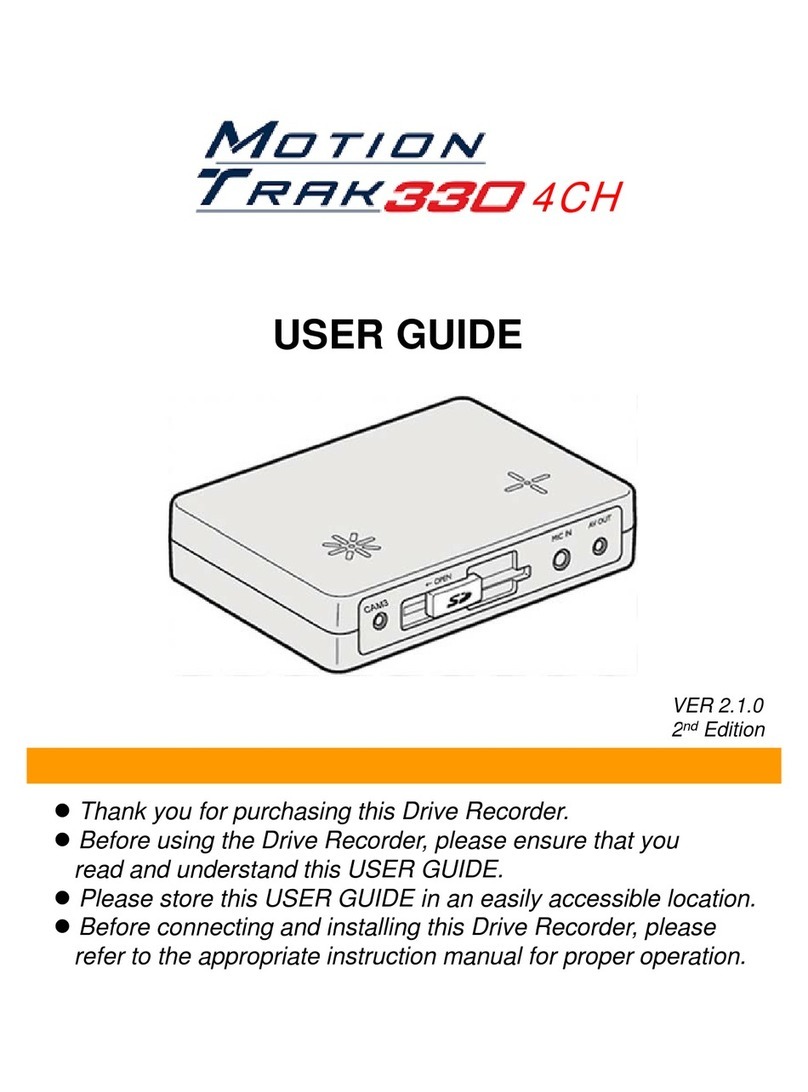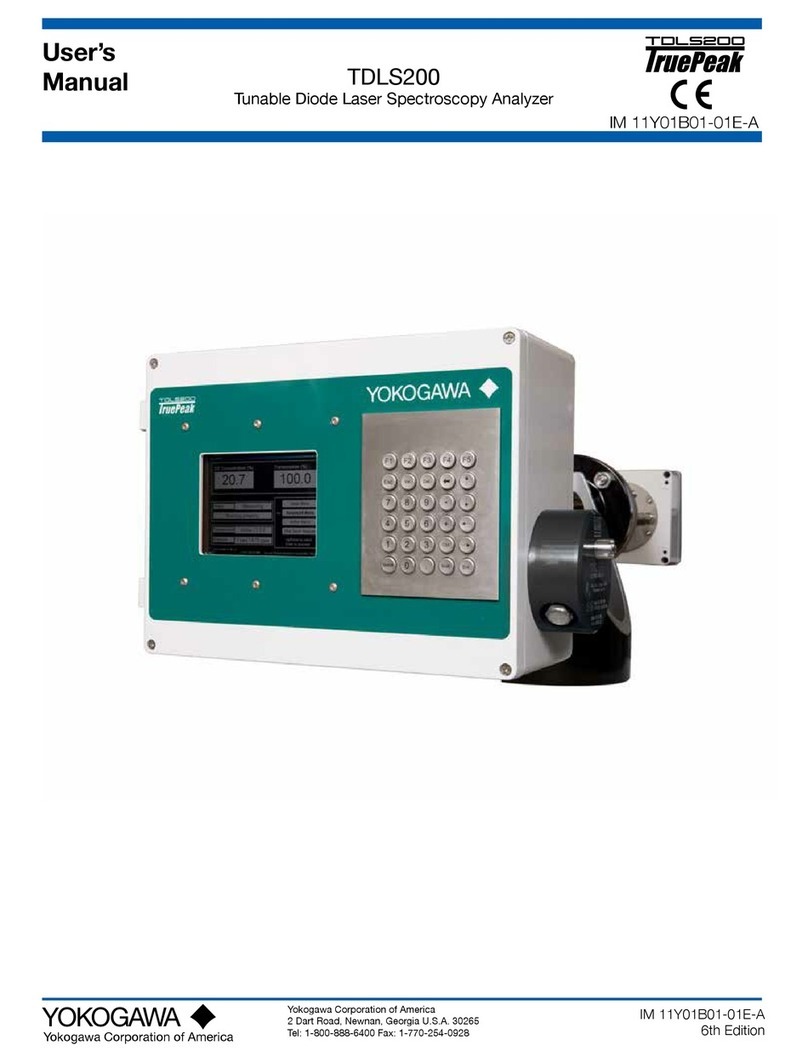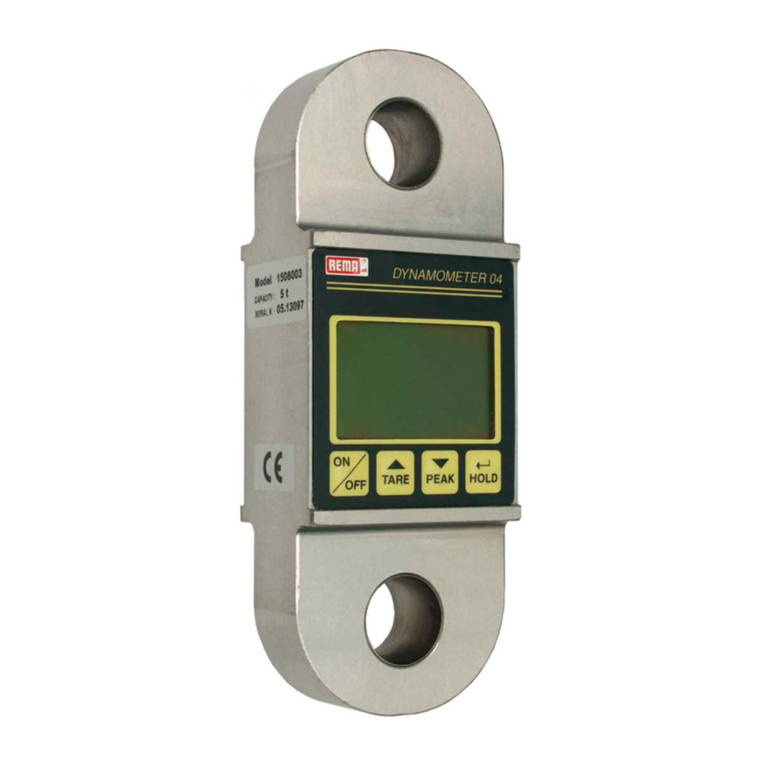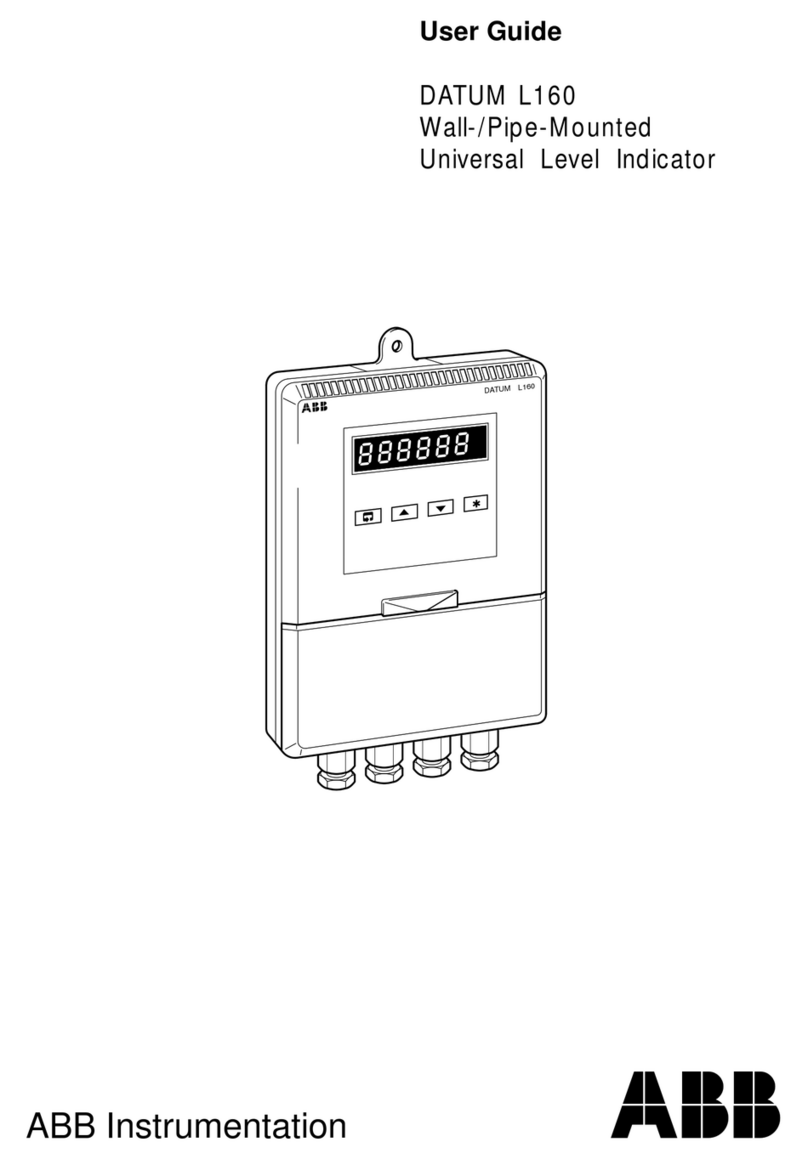Siko MSK5100 Operation manual

MSK5100 +MB500+EM500 Datum 02.09.2010 Art.Nr. 84624 Änd. Stand 292/10 1
MSK5100
MB500
EM500
DEUTSCH
Sensordarstellungen sind exemplarisch und gültig
für alle Bauformen, sofern nicht gesondert be-
schrieben.
1. Gewährleistungshinweise
Lesen Sie vor der Montage und der Inbetriebnahme
dieses Dokument sorgfältig durch. Beachten Sie zu
Ihrer eigenen Sicherheit und der Betriebssicherheit
alle Warnungen und Hinweise.
Ihr Produkt hat unser Werk in geprüftem und be-
triebsbereitem Zustand verlassen. Für den Betrieb
gelten die angegeben Spezifikationen und die
Angaben auf dem Typenschild als Bedingung.
Garantieansprüche gelten nur für Produkte der
Firma SIKO GmbH. Bei dem Einsatz in Verbindung
mit Fremdprodukten besteht für das Gesamtsystem
kein Garantieanspruch.
Reparaturen dürfen nur im Werk vorgenommen
werden. Für weitere Fragen steht Ihnen die Firma
SIKO GmbH gerne zur Verfügung.
2. Identifikation
Magentband: Das Magnetband ist durch eine fort-
laufende Bedruckung identifizierbar.
•
•
•
•
Magnetsensor, Endschaltermagnet: Das Typen-
schild zeigt den Gerätetyp mit Variantennummer.
Die Lieferpapiere ordnen jeder Variantennummer
eine detaillierte Bestellbezeichnung zu.
z.B. XXXXXXX-0023
Varianten-Nr.
Geräte-Typ
3. Mechanische Montage
Die Montage darf nur gemäß der angegebenen IP-
Schutzart vorgenommen werden. Das System muss
ggfs. zusätzlich gegen schädliche Umwelteinflüs-
se, wie z.B. Spritzwasser, Lösungsmittel, Staub,
Schläge, Vibrationen, starke Temperaturschwan-
kungen geschützt werden.
3.1 Montage Magnetband
Die Montage muss plan zur Montagefläche bzw. der
zu messenden Strecke erfolgen. Welligkeiten ver-
schlechtern immer die Messgenauigkeit.
Überall wo aufgrund unzureichender Befestigungsmöglichkeiten
keine geeignete Montage des Magnetbandes möglich ist, kann das
Magnetband in eine als Zubehör lieferbare Profilschiene (z.B. Typ
PS oder PS1) montiert werden. Dadurch entsteht eine kompakte
Magnetbandeinheit.
Aus technischen Gründen muss bei der Länge,
gegenüber der Messstrecke, ein Zumaß von min.
60mm berücksichtigt werden.
Achtung! Um optimale Verklebungen zu errei-
chen müssen alle antiadhäsiven Fremdsubstanzen
(Öl, Fett, Staub usw.) durch möglichst rückstands-
los verdunstende Reinigungsmittel entfernt wer-
den. Als Reinigungsmittel eignen sich u.a. Ketone
(Aceton) oder Alkohole, die u.a. von den Firmen
Loctite und 3M als Schnellreiniger angeboten wer-
den. Die Klebeflächen müssen trocken sein und es
ist mit höchstmöglichem Anpreßdruck zu verkle-
ben. Die Verklebungstemperatur ist optimal zwi-
schen 20°C und 30°C in trockenen Räumen.
Tip! Bei Verklebung langer Bänder sollte die
Schutzfolie des Klebebandes über eine kurze Teil-
strecke abgezogen werden, um das Band zu fixie-
ren. Daraufhin erfolgt das Ausrichten des Bandes.
Nun kann über die restliche Länge die Schutzfolie,
unter gleichzeitigem Andruck des Bandes, seitlich
herausgezogen werden (als Hilfsmittel kann eine
Tapetenandrückwalze verwendet werden).
Montageschritte (Abb. 1)
Befestigungsfläche (1) sorgfältig reinigen.
Am Magnetband die Schutzfolie (2) des Klebe-
bandes (3) entfernen.
Magnetband (4) aufkleben.
•
•
•
Benutzerinformation
MSK5100 Magnetsensor
MB500 Magnetband
EM500 Endschaltermagnet
Chargennummer
Referenzpunkt
Werkstoff-Trägerband
Genauigkeit
MB Typ
MBxxxx GEK WT RP NNNNNN

2 MSK5100 +MB500+EM500 Datum 02.09.2010 Art.Nr. 84624 Änd. Stand 292/10
Abb. 6: Definition der Zählrichtung mit Magnetband
und Montage Sensor/Magnetband, Abstandsmaße,
Toleranzen
0.1mm ... 2.0mm
Abstand Sensor/Magnetband
Maximale Fluchtungsfehler
< 1°
< 3°
< 3°
aktive Seite
Verfahrrichtung
Kabelabgangs-
richtung
Signal
A vor B
Zul. Abweichung
Mitte Band/
Sensor: ±2mm
Abb. 2 Abb. 3
Abb. 4 Abb. 5
Abb. 1: Montage Magnetband
Magnetbandoberfläche sorgfältig reinigen.
Am Abdeckband (5) die Schutzfolie (6) des Kle-
bebandes entfernen.
Abdeckband aufkleben (an beiden Enden leicht
überlappen lassen).
Die überlappenden Enden des Abdeckbandes gegen
Ablösen sichern.
•
•
•
•
Achtung! Die Beeinflussung durch magnetische
Felder ist zu vermeiden. Insbesondere dürfen kei-
ne Magnetfelder (z.B. Haftmagnete oder andere
Dauermagnete) in direkten Kontakt mit dem Ma-
gnetband geraten. In stromlosem Zustand werden
Bewegungen oder Verstellungen des Magnetsen-
sors von der Folgeelektronik nicht erkannt und
erfasst.
Montagebeispiele
Die einfache Montageart, durch angeschrägtes
Schutzband (Abb. 2), ist nur in sehr geschützter
Umgebung zu empfehlen. Bei ungeschützer Um-
gebung besteht Abschälgefahr. In solchen Fällen
sind Montagearten, wie in Abb. 3 und 4 gezeigt,
geeigneter.
Den optimalen Schutz bietet die Montage in ei-
ner Nut (Abb. 5), die so tief sein sollte, dass das
Magnetband vollständig darin eingebettet werden
kann.
3.2 Montage Magnetsensor MSK5100
Der Magnetsensor MSK5100 kann durch Verwen-
dung von 2 Schrauben M3 über die Langlöcher
befestigt werden. Es wird empfohlen die beilie-
genden Befestigungsschrauben und Federringe zu
verwenden (Anzugsmoment 1Nm).
Kabel sind so zu verlegen, dass keine Beschä-
digungsgefahr besteht. Zugentlastung und
wenn nötig Schleppkette oder Schutzschlauch
vorsehen.
Auf richtige Ausrichtung bezüglich der
Zählrichtung achten (Abb. 6). Dies ist uner-
heblich falls sich die Zählrichtung in der elektro-
nischen Auswertung umkehren läßt (wie z.B. bei
den Magnetbandanzeigen von SIKO).
Achtung! Die Toleranz- und Abstandsmaße müs-
sen über die gesamte Messstrecke eingehalten
werden.
Anwendung LINEAR MSK5100 mit MB500:
•
•
3.3 Montage Endschaltermagnet EM500
Der Endschaltermagnet EM500 kann mit Hilfe der
Langlöcher zum tatsächlichen Schaltpunkt des
Magentsensors MSK5100 justiert werden. EM 500
muss mittig zum jeweiligen End- oder Referenz-
schalter positioniert werden.

MSK5100 +MB500+EM500 Datum 02.09.2010 Art.Nr. 84624 Änd. Stand 292/10 3
Abb. 8: Open Collector mit Relais
Endschalter 1
Endschalter R
Endschalter 2
Abb. 7: Endschaltermagnet
Endschalter 1 Endschalter 2
für M3 Schrauben
Referenzschalter
4. Elektrischer Anschluss
Verdrahtungsarbeiten dürfen nur spannungslos
erfolgen!
Vor dem Einschalten sind alle Leitungsanschlüsse
und Steckverbindungen zu überprüfen.
Hinweise zur Störsicherheit
Alle Anschlüsse sind gegen äußere Störeinflüsse
geschützt. Der Einsatzort ist aber so zu wählen,
dass induktive oder kapazitive Störungen nicht
auf den Sensor oder dessen Anschlussleitung
einwirken können! Durch geeignete Kabelfüh-
rung und Verdrahtung können Störeinflüsse (z.B.
von Schaltnetzteilen, Motoren, getakteten Reg-
lern oder Schützen) vermindert werden.
Erforderliche Maßnahmen:
Nur geschirmtes Kabel verwenden. Den Kabel-
schirm beidseitig auflegen. Litzenquerschnitt der
Leitungen min. 0,14mm²; max. 0,5mm².
Die Verdrahtung von Abschirmung und Masse
(0V) muss sternförmig und großflächig erfolgen.
Der Anschluss der Abschirmung an den Potenti-
alausgleich muss großflächig (niederimpedant)
erfolgen.
Das System muss in möglichst großem Abstand von
Leitungen eingebaut werden, die mit Störungen
belastet sind; ggfs. sind zusätzliche Maßnahmen
wie Schirmbleche oder metallisierte Gehäuse
vorzusehen. Leitungsführungen parallel zu Ener-
gieleitungen vermeiden.
Schützspulen müssen mit Funkenlöschgliedern
beschaltet sein.
Spannungsversorgung
Die Spannungswerte sind abhängig von der Sen-
sorausführung und sind den Lieferpapieren sowie
dem Typenschild zu entnehmen.
•
•
•
•
•
•
z.B.: 6.5VDC ... 30VDC
Achtung! Die maximale Länge des Anschlusskabels
zwischen Sensor und Nachfolgeelektronik beach-
ten.
4.1 Anschlusshinweis nach RS422 Norm
Enschalter:
Bei der Beschaltung ist die max. Spannung und
der max. zugelassene Strom zu beachten:
Umax = 50V
Imax = 50mA
Die Endschalter sind als Open-Collector-Ausgang
(OC) ausgeführt und dienen dazu, einen Anschluss
an ein höheres Spannungsniveau zu erlauben.
Ohne weitere Beschaltung des Ausgangs, kann z.B.
ein Relais an den Ausgang geschaltet werden. Um
den OC-Ausgang des Sensors zu schützen ist es
zwingend erforderlich, das Relais mit einem Lösch-
glied (z.B. Freilaufdiode) zu beschalten. Alternativ
wäre auch eine Optoentkopplung möglich.
Werden die Ausgänge nicht benötigt, müssen diese
wahlweise mit einem Pull Up Widerstand beschal-
tet oder auf Masse gelegt werden.

4 MSK5100 +MB500+EM500 Datum 02.09.2010 Art.Nr. 84624 Änd. Stand 292/10
Abb. 11: Anschlussart E8
Ansichtseite = Steckseite Stifteinsatz
so kurz wie
möglich
Schirm
Abb. 10: Anschluss E1
Abb. 9: Open Collector mit Pull Up Widerstand bzw.
Masseschaltung
E8: Anschluss mit 9- oder 15-pol. D-SUB Stecker.
4.2 Anschlussarten
E1: Anschluss mit offenen Kabelenden.
Achtung! Verzinnte Litzen dürfen nicht in Verbin-
dung mit Schraubklemmverbindungen eingesetzt
werden.
nicht invertiert
und Endlage
invertiert mit Index-
signal und Endlage
Signal
rot rot A
orange orange B
- - - blau I, R
braun braun +UB
schwarz schwarz GND
- - - gelb /A
- - - grün /B
- - - violett /I, /R
gelb grau L1
grün weiß L2
- - - Schirm Schirm
invertiert mit Indexsignal oder
Endlage
Signal
rot A
orange B
blau I, R, L1
braun +UB
schwarz GND
gelb /A
grün /B
violett /I, /R, L2
Ummantelung entfernen.
Schirm auftrennen und verdrillen.
Litzen ca. 5mm abisolieren und verdrillen.
Aderendhülsen aufquetschen.
1.
2.
3.
4.
nicht invertiert
und Endlage
invertiert mit Index-
signal und Endlage
Signal
1 7 A
2 6 B
- - - 4 I, R
3 12 +UB
4 10 GND
- - - 8 /A
- - - 5 /B
- - - 3 /I, /R
5 1 L1
6 2 L2
- - - 14 Schirm
7 - 9 9, 11, 13, 15 - - -
invertiert mit Indexsignal oder
Endlage
Signal
1 A
2 B
3 I, R, L1
4 +UB
5 GND
6 /A
7 /B
8 /I, /R, L2
9 - - -
5. Inbetriebnahme
Nach ordnungsgemäßer Montage und Verdrahtung
kann das Messsystem durch Einschalten der Ver-
sorgungsspannung in Betrieb genommen werden.
Das Gerät initialisiert sich selbstständig nach dem

MSK5100 +MB500+EM500 Datum 02.09.2010 Art.Nr. 84624 Änd. Stand 292/10 5
L1 Power A B I/R L2
Abb. 12: Leuchtdioden
Einschalten. Die "Power"-Leuchtdiode (grün) im
Sensorgehäuse leuchtet. Beim Verfahren des Ma-
gnetsensors über das Magnetband blinken die
Leuchtdioden A, B und I/R (rot) entsprechend auf.
L1 oder L2 leuchten solange der entsprechende
Endschaltermagnet betätigt wird (siehe Abb. 12).
V = 1
2,50 x 0,8 = 0,32m/s
Das Messsystem MSK5100/MB500/EM500 ist Be-
standteil eines inkrementalen Messsystem, wel-
ches zur absoluten Messung an einer definierten
Stelle (Referenzpunkt) referenziert werden muss.
Die seitliche Referenzierung erfolgt mittels Refe-
renzschalter (MSK5100) und EM500. Um eine bes-
sere Referenzierungsgenauigkeit zu erreichen ist
das Signal vom Endschaltermagnet EM500 mit dem
internen periodischem Index verknüpft.
6. Verfahrgeschwindigkeiten (m/s)
Formel zur Berechnung der Verfahrgeschwindigkeit:
Es ist zu beachten, dass im Stillstand Impulse
von der Breite des eingestellten Pulsabstandes
auftreten können (bedingt durch das interne In-
terpolationsverfahren).
Achtung! Bei der Dimensionierung der Nachfol-
geelektronik ist zu beachten, dass diese für den
eingestellten Pulsabstand bzw. Zählfrequenz aus-
gelegt ist.
Signalfolge
Hinweis: Die Lage des Index- bzw. Referenzsignals
I+R zu den Signalen A und B ist nicht definiert und
kann von der Zeichnung abweichen.
Hinweis: Bei Index-/Referenzsignalbreite von 4
Inkrementen (= 360°), ist der Index/Referenz erst
nach dem 5. Zählschritt (Inkrement) auswertbar.
Nach dem Einschalten der Betriebsspannung ent-
sprechende Verzögerung berücksichtigen.
Beispiel:
Auflösung: 1µm
Pulsabstand: 2,50µs
Auflösung im µm
Pulsabstand
(µs)
Zählfre-
quenz (kHz)
1 5 10 25 50 100
Verfahrgeschwindigkeit in m/s
0,01 0,06 0,12 0,30 0,61 1,21 66,00 3,79
0,03 0,13 0,25 0,63 1,25 2,50 32,00 7,81
0,05 0,25 0,50 1,25 2,50 5,00 16,00 15,63
0,10 0,50 1,00 2,50 5,00 10,0 8,00 31,25
0,20 1,00 2,00 5,00 10,0 20,0 4,00 62,50
0,32 1,60 3,20 8,00 16,0 25,0 2,50 100,00
0,80 4,00 8,00 20,0 25,0 25,0 1,00 250,00
1,60 8,00 16,0 25,0 25,0 25,0 0,50 500,00
4,00 20,0 25,0 25,0 25,0 25,0 0,20 1250,00
7. Ausgangssignale
Die Auswerteelektronik setzt die magnetischen
Längeninformationen des Magnetsensors in in-
krementale Ausgangssignale um. Die Ausgabe der
Signale erfolgt geschwindigkeitsproportional.
8. Wartung
Die Oberfläche des Magnetbandes ist bei starker
Verschmutzung durch Staub, Späne, Feuchtigkeit
usw., von Zeit zu Zeit mit einem weichen Lappen
zu reinigen.
9. Fehlerbehandlung
Typische Fehler, die bei Anbau und Betrieb auf-
treten:
Das Magnetband wurde falsch montiert / aktive
Seite nach unten (siehe Kapitel 3.1).
Zum Schutz des Magnetbandes wurde nicht das
mitgelieferte Abdeckband verwendet. Das Abdeck-
band darf nicht magnetisierbar sein.
Der Sensor ist nicht, oder nicht korrekt ange-
schlossen (Pinbelegung Kapitel 4.2).
Die Abstandstoleranz zwischen Sensor und
•
•
•
•

6 MSK5100 +MB500+EM500 Datum 02.09.2010 Art.Nr. 84624 Änd. Stand 292/10
Magnetband wurde nicht eingehalten (über die
gesamte Messstrecke!), der Sensor streift auf
dem Magnetband (Abb. 6).
Die Abstandstoleranz zwischen Endschaltermag-
net und Magentsensor wurde nicht eingehalten
(Abb. 7).
Kabelunterbrechung/Abtrennung durch scharfe
Kanten/Quetschung.
Der Sensor ist mit der aktiven Seite vom Band
abgewandt montiert (Abb. 6).
Der Sensor wurde nicht entsprechend Abb. 6
ausgerichtet.
•
•
•
•

MSK5100 +MB500+EM500 Datum 02.09.2010 Art.Nr. 84624 Änd. Stand 292/10 7
MSK5100
MB500
EM500
ENGLISH
Exemplary sensor illustrations are valid for all sen-
sor types unless described separately.
1. Warranty information
In order to carry out installation correctly, we
strongly recommend this document is read very
carefully. This will ensure your own safety and
the operating reliability of the device.
Your device has been quality controlled, tested
and is ready for use. Please observe all warnings
and information which are marked either directly
on the device or specified in this document.
Warranty can only be claimed for components
supplied by SIKO GmbH. If the system is used
together with other products, there is no warranty
for the complete system.
Repairs should be carried out only at our works.
If any information is missing or unclear, please
contact the SIKO sales staff.
2. Identification
Magnetic strip: identification by printing on the
strip.
•
•
•
•
Magnetic sensor, Limit switch magnet: Please
check the particular type of unit and type number
from the identification plate. Type number and the
corresponding version are indicated in the delivery
documentation.
e.g. XXXXXXX-0023
version number
type of unit
3. Installation
For mounting, the degree of protection specified
must be observed. If necessary, protect the unit
against environmental influences such as sprayed
water, dust, knocks, extreme temperatures.
3.1 Mounting the magnetic strip
The mounting surface / measuring track must be
flat. Buckles or bumps will lead to measuring in-
accuracies.
For applications which do not allow properly glueing of the magne-
tic strip, it can be inserted into a profile rail (accessory) - e.g. rail
type PS or PS1 thus forming a compact mounting unit.
For technical reasons the strip should be min.
60mm longer than the actual measuring distance.
Attention! To guarantee optimal adhesion oil,
grease dust etc. must be removed by using clean-
sing agents which evaporate without leaving resi-
dues. Suitable cleansing agents are e.g. ketones
(acetone) or alcohols; Messrs. Loctite and 3M can
both supply such cleansing liquid. Make sure that
the surface to be glued is dry and apply the strip
with maximum pressure. Glueing should preferably
be undertaken at temperatures between 20°C to
30°C and in dry atmosphere.
Advice! Wh en applying long pieces of magnetic
strip do not immediately remove the complete pro-
tective foil, but rather peel back a short part from
the end sufficient to fix the strip. Now align the
strip. As the protective strip is then peeled back
and out press the tape firmly onto the mounting
surface. A wall paper roller wheel could be used to
assist in applying pressure onto the magnetic strip
when fixing it in position.
Mounting steps (see fig. 1)
Clean mounting surface (1) carefully.
Remove protective foil (2) from the adhesive
side of the magnetic strip (3).
Stick down the magnetic strip (4).
Clean surface of magnetic strip carefully.
Remove protective foil (6) from adhesive tape on
the cover strip (5).
•
•
•
•
•
User Information
MSK5100 Magnetic sensor
MB500 Magnetic strip
EM500 Limit switch magnet
batch number
reference point
carrier strip
accuracy
MB type
MBxxxx GEK WT RP NNNNNN

8 MSK5100 +MB500+EM500 Datum 02.09.2010 Art.Nr. 84624 Änd. Stand 292/10
Fig. 2 Fig. 3
Fig. 4 Fig. 5
Fig. 1: Mounting of the magnetic strip
Fig. 6: Definition of the counting direction with
magnetic strip and assemblage sensor/magnetic
ring, gap measure, tolerances
Gap sensor/magnetic strip
Maximum alignment error
active side
Travel direction
Direction of
outgoing cable
Signal
A before B
Admissable
deviatoion
middle of
tape/sensor:
±2mm
0.1mm ... 2.0mm
< 1°
< 3°
< 3°
Fig. 7: Limit switch magnet
Limit switch 1 Limit switch 2
for M3 screw
reference switch
Fix cover strip (both ends should slightly over-
lap).
Also fix cover strip's ends to avoid unintenti-
onal peeling.
•
•
Attention! Do not expose the system to magne-
tic fields. Any direct contact of the magnetic strip
with magnetic fields (e.g. adhesive magnets or
other permanent magnets) is to be avoided. Sen-
sor movements during power loss are not captured
by the follower electronics.
Mounting examples
Mounting with chamfered ends (fig. 2) is not re-
commended unless the strip is installed in a safe
and protected place without environmental influ-
ences. In less protected mounting places the strip
may peel. There we recommend mounting accord.
to fig. 3 and 4.
Mounting in a groove (fig. 5) best protects the
magnetic strip. The groove should be deep enough
to totally embed the magnetic strip.
3.2 Mounting of the Magnetic sensor MSK5100
The magnetic sensor MSK5100 can be fastened by
using two bolts M3 over the elongated holes. We
recommend to use the enclosed fixing screws and
washer springs (fastening torque 1Nm).
Cables should be layed in such a way that there
is no danger of damaging. Provide tension relief
and drag chain or casing, if necessary.
Observe the correct alignment with regard to
the counting direction (fig. 6). This does not
•
•
apply if the counting direction can be reversed
in the electronic interpretation (e.g. in SIKO's
magnetic-strip displays).
Attention! The tolerance and gap measures must
be observed over the whole measuring length.
LINEAR application MSK5100 with MB500:
3.3 Mounting of the Limit switch magnet EM500
Via oval holes, limit switch magnet EM500 can be
aligned to MSK5100 magnetic sensor's actual swit-
ching point. EM500 has to be positioned in the
middle of each end or limit switch.

MSK5100 +MB500+EM500 Datum 02.09.2010 Art.Nr. 84624 Änd. Stand 292/10 9
Fig. 8: Open Collector with relay
Limit Switch 1
Limit Switch R
Limit Switch 2
Fig. 9: Open Collector with pull-up resistor or ground
connection
4. Electrical connection
Wiring must only be carried out with power off!
Check all lines and connections before switching
on the equipment!
Interference and distortion
All connections are protected against the effects
of interference. The location should be selected
to ensure that no capacitive or inductive in-
terferences can affect the sensor or the con-
nection lines! Suitable wiring layout and choice
of cable can minimise the effects of interference
(e.g. interference caused by SMPS, motors, cyclic
controls and contactors).
Necessary measures:
Only screened cable should be used. Wire cross sec-
tion is to be at least 0,14mm², max. 0,5mm².
Wiring to the screen and ground (0V) must
be secured to a good point. Ensure that the
connection of the screen and earth is made to
a large surface area with a sound connection to
minimise impedance.
The system should be positioned well away from
cables with interference; if necessary a protective
screen or metal housing must be provided. The
running of wiring parallel to the mains supply
should be avoided.
Contactor coils must be linked with spark sup-
pression.
Supply voltage
The voltages depend on the sensor designs; they
are to be taken from the delivery documentation
and the identification plate.
e.g.: 6,5VDC ... 30VDC
Attention! When connecting sensor and follower
electronics, please do not exceed the max. admis-
sable cable length.
•
•
•
•
•
•
4.1 Connection note acc. to RS422 standard
Limit Switch:
For wiring, follow the specificatins for maximum
voltage and maximum permissible current:
Umax = 50V
Imax = 50mA
The limit switches are designed as Open-Collector
(OC) output and serve for enabling connection to
a higher voltage level. For instance, a relay can be
connected to the output without additional wiring
of the output. In order to protect the sensor's OC
output it is mandatory to wire the relay with a
quenching circuit (e.g. free-wheeling diode). Al-
ternately, opto-decoupling would be possible.
If the outputs are not required, they must either
be wired with a pull-up resistor or connected to
ground.

10 MSK5100 +MB500+EM500 Datum 02.09.2010 Art.Nr. 84624 Änd. Stand 292/10
Fig. 11: Connection type E8
viewing side = plug-in side plug pin
Fig. 10: Connection type E1
as short as
possible
screening
4.2 Connection type
E1: Flying leads.
Attention! Tinned strands must not used in com-
bination with screw/clamp connections.
not inverted
and limit
switch
inverted with index
signal and limit
switch
Signal
red red A
orange orange B
- - - blue I, R
brown brown +UB
black black GND
- - - yellow /A
- - - green /B
- - - violet /I, /R
yellow grey L1
green white L2
- - - screening screening
inverted with index signal or limit
switch
Signal
red A
orange B
blue I, R, L1
brown +UB
black GND
yellow /A
green /B
violet /I, /R, L2
Remove cable coating.
Open screening and twist it.
Strip stranded wires to a length of 5mm and
twist them.
Pinch stranded wires.
1.
2.
3.
4.
E8: Connection with 9- or 15-pole D-SUB plug.
not inverted
and limit
switch
inverted with index
signal and limit
switch
Signal
1 7 A
2 6 B
- - - 4 I, R
3 12 +UB
4 10 GND
- - - 8 /A
- - - 5 /B
- - - 3 /I, /R
5 1 L1
6 2 L2
- - - 14 screening
7 - 9 9, 11, 13, 15 - - -
inverted with index signal or limit
switch
Signal
1 A
2 B
3 I, R, L1
4 +UB
5 GND
6 /A
7 /B
8 /I, /R, L2
9 - - -
5. Commissioning
Following proper installation and wiring, the
measuring system can be commissioned by
switching on the supply voltage. After switching
on, the device initializes itself independently. The
"power" LED (green) in the sensor housing lights
up. While the magnetic sensor travels over the
magnetic strip, the LEDs A, B, and I/R (red) are
lighting accordingly. L1 or L2 are glowing as long
as the respective limit switch magnet is actuated
(see fig. 12).

MSK5100 +MB500+EM500 Datum 02.09.2010 Art.Nr. 84624 Änd. Stand 292/10 11
Fig. 12: LED
L1 Power A B I/R L2
The measuring system MSK5100/MB500 is a com-
ponent of an incremental measuring system which
must be referenced at a defined position (refe-
rence point) for absolute measurement. For this
purpose, the reference signal must be linked to
the signal of a reference value encoder (e.g. pro-
ximity switch). Lateral referencing is made via re-
ference switch (MSK5100) and EM500. For getting
a better referencing precision, teh signal of limit
switch EM500 is linked with a periodal index.
6. Travel speeds (m/s)
Formula for calculating the travel speed:
V = 1
2,50 x 0,8 = 0,32mm/s
Attention! When dimensioning the follow-on
electronics please take care that it is adjusted
to the set pulse interval or counting frequency,
respectively.
Signal sequence
Example:
Resolution: 1µm
Pulse interval: 2,50µs
Resolution µm
Pulse inter-
val (µs)
Counting
frequency
(kHz)
1 5 10 25 50 100
Travel speed m/s
0,01 0,06 0,12 0,30 0,61 1,21 66,00 3,79
0,03 0,13 0,25 0,63 1,25 2,50 32,00 7,81
0,05 0,25 0,50 1,25 2,50 5,00 16,00 15,63
0,10 0,50 1,00 2,50 5,00 10,0 8,00 31,25
0,20 1,00 2,00 5,00 10,0 20,0 4,00 62,50
0,32 1,60 3,20 8,00 16,0 25,0 2,50 100,00
0,80 4,00 8,00 20,0 25,0 25,0 1,00 250,00
1,60 8,00 16,0 25,0 25,0 25,0 0,50 500,00
4,00 20,0 40,0 25,0 25,0 25,0 0,20 1250,00
7. Output signal
The translation module translates the length
information of the magnetic sensor into incre-
mental output signals with real-time processing of
the output signals.
Please note that pulses having the width of
the pulse interval set can occur at standstill of
the device (caused by the internal interpolation
method).
Note: The position of the index or reference sig-
nal I+R, respectively, with respect to signals A
and B is not defined and can deviate from the
drawing.
Note: With a 4-increment wide (= 360°) index/
reference signal, index/reference signal interpre-
tation can be made after the 5th counting step
(increment) only. Corresponding time delay has to
be considered when power is switched on.
8. Maintenance
We recommend cleaning the magnetic strip's sur-
face from time to time with a soft rag. This avo-
ids dirt (dust, chips, humidity ...) sticking to the
strip.
9. Trouble shooting
Below are some typical errors which may occur du-
ring installation and operation:
Magnetic strip incorrectly mounted (active sur-
face must be mounted towards the sensor) (see
chapter 3.1).
Use of foreign protective strip. Must always be
non-magnetic.
Sensor not or incorrectly connected (pin connec-
tion, see chapter 4.1).
Tolerance for the gap between magnetic sensor
and magnetic strip not observed over the total
travel distance (see fig. 6).
The admissable gap between limit switch ma-
•
•
•
•
•

12 MSK5100 +MB500+EM500 Datum 02.09.2010 Art.Nr. 84624 Änd. Stand 292/10
SIKO GmbH
Werk / Factory:
Weihermattenweg 2
79256 Buchenbach-Unteribental
Postanschrift / Postal address:
Postfach 1106
79195 Kirchzarten
Telefon/Phone +49 7661 394-0
Telefax/Fax +49 7661 394-388
E-Mail info@siko.de
Internet www.siko.de
Service [email protected]
gnet and magnetic sensor was not respected.
(see fig. 7)
Cable squeezed/interrupted/cut by sharp
edges.
Sensor's active side not mounted towards the
magnetic strip (see fig. 6).
Sensor has not been aligned according to fig.
6.
•
•
•
This manual suits for next models
2
Table of contents
Languages:
Other Siko Measuring Instrument manuals
Popular Measuring Instrument manuals by other brands

Dräger
Dräger Interlock 7000 Instructions for use

Endress+Hauser
Endress+Hauser Proline 500 Brief operating instructions

geo-FENNEL
geo-FENNEL Multi-Digit Pro + user manual
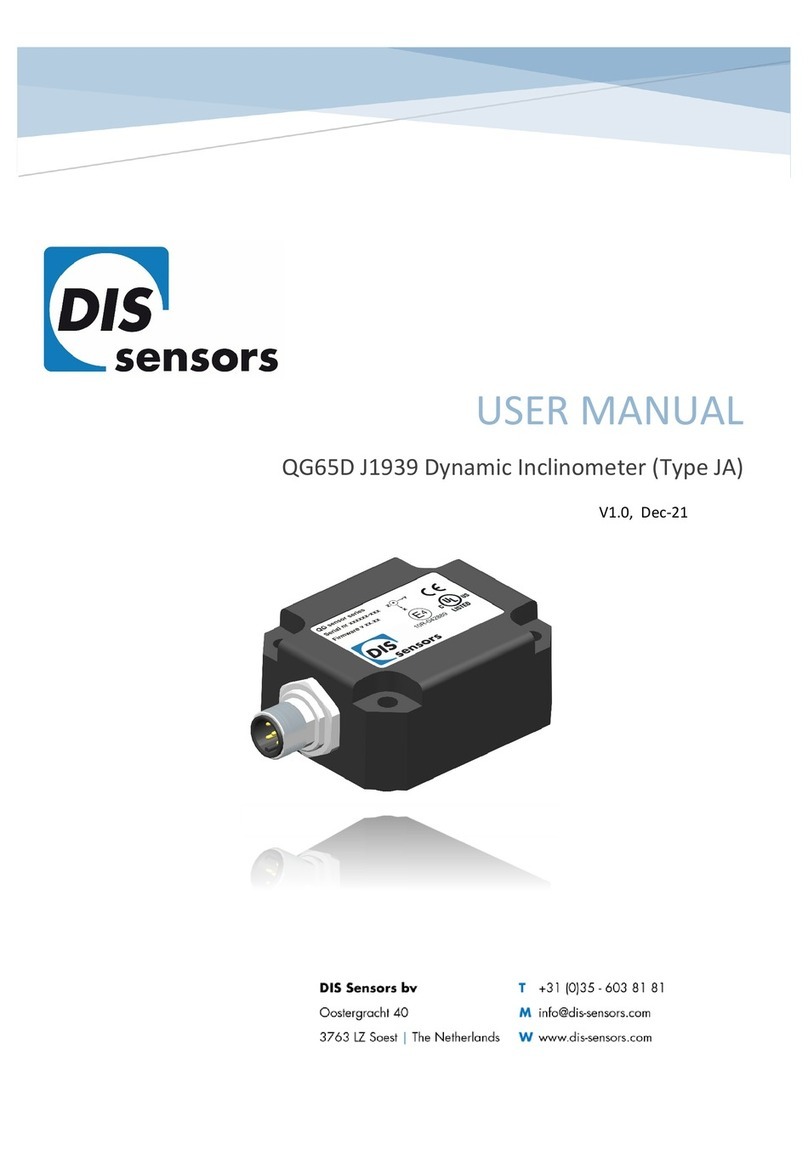
DIS Sensors
DIS Sensors QG65D user manual

Endress+Hauser
Endress+Hauser prowirl 70 technical information
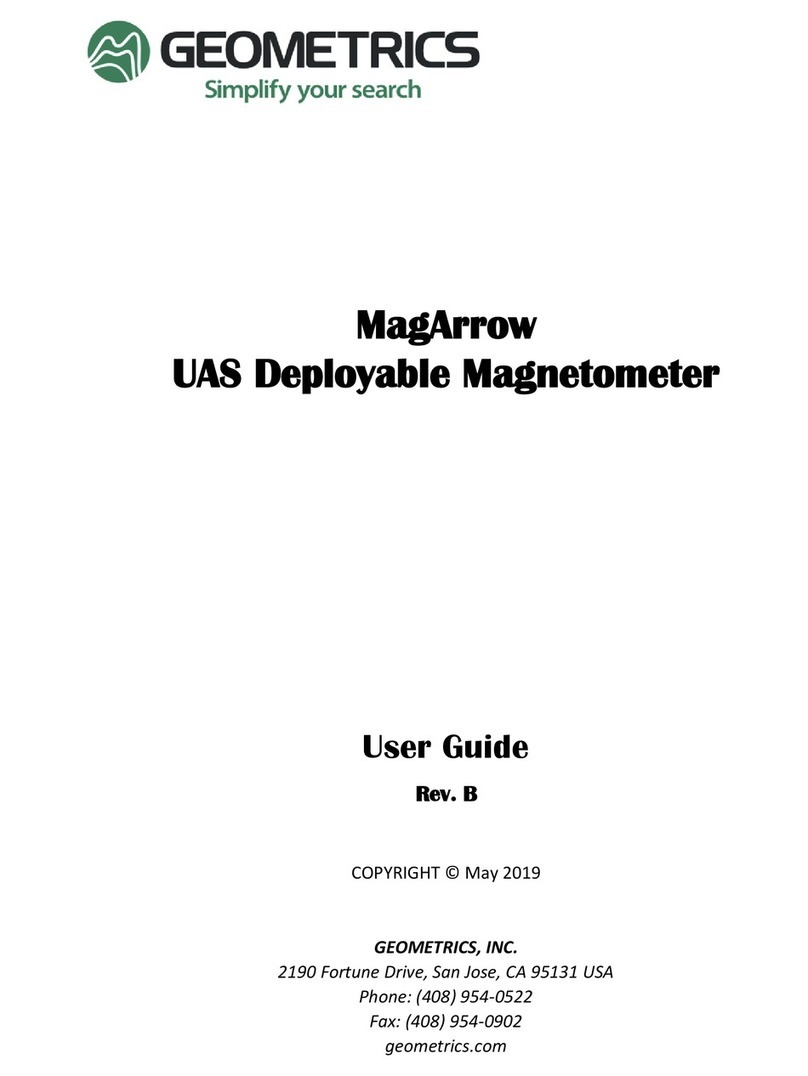
Geometrics
Geometrics MagArrow user guide
